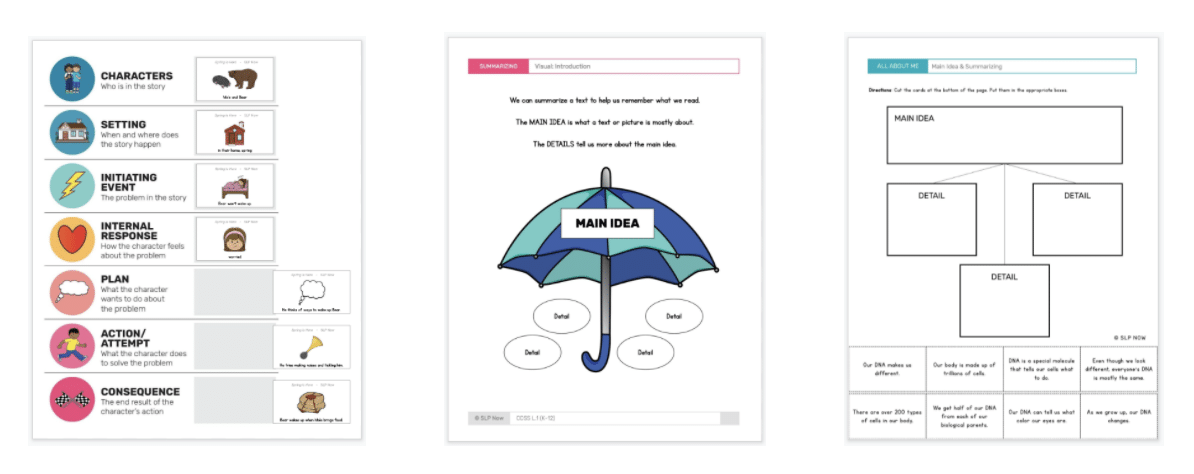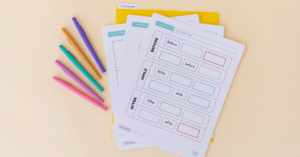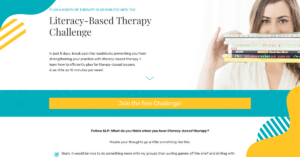Listen on Apple Podcasts Listen on Spotify
Welcome to another episode of the SLP Now podcast! We’re on week four of our six-week series about planning a month of literacy-based therapy, with units that will meet the needs of your entire school-aged caseload!
For the last three weeks, we’ve used Dr. Ukrainetz’s five step literacy-based therapy framework to work through a month of therapy planning for three units: a play-based early language unit, a picture book, and a fiction article.
Today, we’re taking the next step on our therapy planning journey with a month of plans for non-fiction article, “Wild Calls in the Springtime Sky.”
This unit is ideal for students in third grade and up, or if they have a good mastery of narrative language. It’s a great way to target more expository language!
🐣 Not sure where to start, or which unit best suits your caseload? No problem!
Take a quick two-minute quiz, and we’ll send you a personalized list of recommended units based on your specific caseload needs — plus resources to help you implement the activities we talk about in this series.
Click here to get your recommended therapy plans
Step one: Pre-story knowledge activation
Dr. Ukrainetz’s five step literacy-based framework is geared towards narrative texts, but Marisha considers that to be more of a guideline than a hard and fast rule. She has taken the principles from this framework and applied it to other texts, which is what this episode is all about!
Remember: there are several strategies Marisha likes to use for pre-story knowledge activation, but she encourages SLPs not to think of them as a guideline instead of a hard and fast rule. 🙃
Consider the options, then choose the best approach based on your student’s needs and goals.
1. Do an article walk
The first thing Marisha likes to do in step on is take a look at the article, which you can access for free with an educator’s account on ReadWorks.
Pull up the article with your students, look at the title, skim some of the paragraphs, and have a conversation about what they know so far. This step will help you assess the base knowledge your students have, and how much they’re able to produce independently.
Taking this step helps to reduce the cognitive load of the activity, which means the whole learning process becomes easier. You can also use that information to decide which activities are going to be the most helpful, and get some ideas for future steps. 👀
If the students have a lot of prior knowledge and a really solid understanding of the article’s content, you might be able to skip some of other suggested activities for pre-story knowledge activation.
2. Fill out a KWL Chart
If your students need more support developing background knowledge about the topic, Marisha recommends using a KWL chart.
👉 A KWL chart is split into three segments: in the first column, we write what we know about the topic, in the second column we write what we want to know, and in the third column we write what we learned.
You can fill in each column of the KWL chart with your students, discussing their existing knowledge about the topic, what they’re curious to learn more about, and what they’ve discovered throughout the session. You can even create this chart while you’re doing the article walk!
In this case, the article is about birds migrating. You can ask your students questions like:
- Do you know what migration is?
- Do you know which birds migrate?
- What are migration patterns?
We can use these questions to get more clarity about where knowledge gaps exist, so that we can bridge them over the course of the sessions and fill out the other columns of our chart!
3. Take a virtual field trip
One of the ways you can help students fill in the background knowledge they need is to do a virtual field trip.
Marisha is a big fan of using YouTube, but there are a ton of other resources out there. For example, there is a video in the PBS Learning Media Library that you can use for this unit. It’s all about migration, and includes examples of different types of birds and their migration patterns.
You can also pull materials from the curriculum, use Google images, library books, or a clip from a documentary. If your school is in an area that has a lot of birds, you may be able to make the virtual field trip a real life one by observing birds in the school yard.
The opportunities here are endless. ✨

4. Pre-fill a summarizing graphic organizer
The last thing Marisha likes to do in step one is pre-fill a summarizing graphic organizer. Based on the article walk, KWL chart, and virtual field trip, she’ll ask students to infer the summary of the article, and fill in some of those details before we actually start reading.
This activity sets your students up for success by providing meaningful exposure to key elements of the article, and giving them a framework to work with.
💡 Keep this first summarizing graphic organizer to compare with the second one they create later — based on what actually happens in the text. You can use these visuals to do some compare/contrast or syntax activities!
And that’s step one of the literacy-based framework!
Remember, you don’t have to do all of these activities to move on to step two. Use your clinical judgment, and make choices based on your students needs and goals.
Step two: Read the article
This is the shortest and simplest step in the whole framework: pull up the article and then read through it!
You can read the article aloud, your students can read it independently, you can do popcorn reading and have each student read a paragraph, or you can play an audio version. There are so many options here, so you can decide what makes the most sense and what is most engaging for your group.
Step three: Post-story comprehension.
Like pre-story activation, there are a few different approaches to this step—and each activity is language rich, meaning you can use it to target any goal.
💡 In SLP Now, we have pre-made units for more than 400 articles and books, including this one! In those units, you’ll find pre-made lists of literal and inferential questions, plus a summarizing graphic organizer.
Learn more about the SLP Now membership
One of Marisha’s favorite things about post-story comprehension is that there are different answers to each question; there is a field of choices for students to work with. You can use the information in the article, scaffolding the skills as students identify the main idea or key details.
1. Literal questions
It’s common to use literal questions when students have a goal to work on answering WH questions, but you can also ask basic questions about the article and target other goals (like grammar or vocabulary) with the students’ responses.
2. Inferential questions
This is a great activity for elementary students because they’re able to tap into their prior knowledge and reference the text to successfully answer these types of questions. They have an opportunity to build on what they already know, and integrate the new learning.
3. Fill out a summarizing grammar organizer
Pull out the summarizing graphic organizer and run through the elements, asking some WH questions. Filling out the summarizing graphic organizer is a language rich activity that you can revisit in multiple steps, and it’s a great bridge to steps four and five.

Step four: Structured skill practice
In step four, we’re going to start some targeted skill practice—including another visit to the summarizing graphic organizer.
Getting students to practice summarizing the text gives them the opportunity to work on those grammar and vocabulary targets, integrating them into the summary.
As students work through this activity, you can assess their skill level and decide how much targeted skill practice to incorporate.
Because these activities are language rich, students will be producing sentences. Throughout the unit, you can recast and model target structures for grammar. Hopefully by the time you get to step four, they’ve had some meaningful exposure and are more prepared for embedded practice. But once again: use your clinical judgment to decide how much time you spend in each step of the framework.
Other activities you can implement with this unit include targeting prefixes and suffixes, or working on compound and complex sentences. To make that super easy, check out the worksheets we have in SLP Now—and remember that just because it says “vocabulary” doesn’t mean that’s the only goal you can target with this worksheets. They can also be used for carryover grammar goals, creating sentences, working on syntax…
Nothing multi-tasks like SLP Now materials! 🤣
Step five: Integrate the new skills
If we’re using a narrative-based text, step five is usually when we would create a parallel story.
The structure of a non-fiction article is a little bit different though. Instead of using a story grammar organizer, we’ve been working with a summarizing graphic organizer. So, instead of creating a parallel story, we’re going to do an activity that requires more expository language and summarizing skills.
One of the ways Marisha likes to make that happen is by getting her students to create a newscast!
This gives them a great opportunity to extend their learning, and integrate the news skills in a fun and engaging way.
There are also options other than a newscast—like creating a short informational video, mini documentary, or newspaper article.
You can be super creative here! The goal is to summarize the information, not create something new.
Once you’ve decided on how your students are going to showcase their skills, they can practice summarizing the information. When everyone has hit mastery, you can “hit publish” and bring all that hard work to life. 💪
There are so many options to choose from here, and the “right” one is the one that works for your students.
And that brings us to the end of our non-fiction article unit!
You can find the links to all of the resources mentioned below, and we’ll be back at it next week with our non-fiction article unit.
Happy SLPing!
LINKS MENTIONED AND RELATED RESOURCES
Wild Calls in the Springtime Sky on ReadWorks
#183: A month of therapy plans using an early language picture book
#184: A month of therapy plans using a picture book
#185: A month of therapy plans using a fiction article
Get unit recommendations for your caseload
PBS Learning Media Library: Bird Migration
Try a 14-day trial of SLP Now for free
At SLP Now, we are hard workers… but we also like to work smarter.
That means we’re constantly improving our materials, therapy planning resources, and the ways we support SLPs like YOU — so you can skip the hard work part and just work smarter. 👇
Inside the SLP Now membership, you’ll find 400+ therapy plans and an organized library of 4,500+ (and counting!) evidence-backed speech therapy materials to help you differentiate your therapy in a matter of minutes.
How is that possible, you ask?
Because we analyzed all the books, identified the targets, and created unit plan pages that suggest activities based on the skills you’re targeting and your students’ needs. This is the one stop shop for all your literacy-based therapy needs, including resources for virtual field trips and visuals to help those concepts stick. All you have to do is click! 🥳
We’re always hard chill at work building out our materials library and adding resources that will save you even more time, so you can spend it doing the things that matter most to you. (Not paperwork. 😅)
You can absolutely implement literacy-based therapy without SLP Now — there are so many free resources out there! — but if you want to cut down the time spent planning and get support from a community of SLPs who are in the trenches with you, it might be the right time to try a membership!
You can sign up for a two week trial that is risk-free and free-free → We won’t even ask for your credit card so there’s no worry about an unexpected subscription!
We’ve talked about so many activity options during this series… but there are even more literacy-based ideas and evidence-based resources waiting for you on the other side of SLP Now. 🤗
Hit the easy button: Start your free trial today!
Subscribe
Subscribe to the SLP Now podcast and stay tuned for our next series. We’re kicking off September by helping you get your data collection, paperwork, and therapy planning processes in tip-top shape!
Listen to The SLP Now Podcast on Apple ★ Spotify ★ Google ★ Stitcher ★ Castbox or wherever you listen to podcasts.
Transcript
00:00 Hello there, and welcome to the SLP now podcast, where we share practical therapy tips and ideas for busy speech language pathologists. Grab your favorite beverage and sit back as we dive into this week's episode.
00:19 This week we are diving into a month long unit for a nonfiction article. This is part of a six episode series where we are sharing month long therapy units for your entire school age caseload from preschool through 12th grade. And we've already had three other episodes, so check out the previous episodes for a early language book, a picture book, and a fiction article. And we have two more units on the way. So this particular unit is ideal for students who are in third grade and up, and this is also ideal if you're wanting to target more expository language. If your students have a good mastery of narrative language and or if the priority is just more nonfiction expository text, then these are the units for you.
01:14 And if you're having a hard time deciding which units are most appropriate for your caseload, check out the show notes@slpnow.com/186 again, slpnow.com/186. This is where you'll find a link to a two minute quiz where you plug in a couple details about your caseload, and then we send you a customized list of recommended units for your caseload. And then you can come back and listen to the relevant podcast episodes and walk into your sessions feeling super confident at the show notes. You'll also find tons of other resources related to this unit. So again, head to slpnow.com/186. Now let's dive into the actual unit. We are going to be reading Wild Calls in the Springtime Sky. This is a nonfiction article that is free on read works, so let's dive into the steps for the unit.
02:18 So step one is pre story knowledge activation. And again, this is using Doctor Ukrainetz's five-step literacy based therapy framework, and the framework is geared towards more narrative text. So take this with a grain of salt, but I found some really nice success using this framework, even with non narrative text. So I'm going to share how I do that in this episode. So for step one, the first thing we want to do is take a look at the article. So we'll pull up the article, look at the title, skim some of the paragraphs, and just have a little bit of a conversation about what we notice, what we know. And this will help me based on how much the students are able to produce around this activity.
03:10 I will then decide which activities are going to be most helpful if they have beautiful conversation around all of these topics, and they have great prior knowledge, then I may skip some of these activities, but some other options to support students if they are struggling with the article walk are to create a KWL chart. So this is, you can fold a piece of paper or just split a piece of paper into three columns. And the K stands for what they know, W stands for what they want to learn, and the L stands for what they learned. And you can do this as you're doing the article walk. Like, you can have them identify what the article is about. In this case, it's birds migrating. And then, okay, so what do you know about birds and their migration patterns?
04:02 Do we even know what migration is? So we write down what we know, and then we can figure out what we want to learn. And then as we go through the rest of the unit, we can fill in what we learned. So one activity idea to help students fill in that background knowledge is to do a virtual field trip. I love finding my virtual field trips on YouTube, but there are tons of other sources for these as well. An example that we found for this unit is a video from the PBS learning media library. And it's all about migration. And it's really cool because it has videos of a bunch of birds and their migration patterns, and it gives additional background information that can be a really nice supplement to the article.
04:49 You can also pull any materials from the curriculum, any other resources that you can come up with. If there are a lot of birds around your school, you might kind of take advantage of that. The opportunities are endless. Then the last thing that I like to do is I have a summarizing graphic organizer. And based on the article walk and our KWL chart and the virtual field trip, I will have students infer what the summary will look like for this article and fill in some of those details. And then that brings us to step two, where we simply read the article. And this is very short and sweet. We just read through it, and I decide, based on the needs of the group, if I'm going to read it, if we're going to listen to the recording, or if we popcorn read.
05:39 And every student it reads in a paragraph, for example. But this is the shortest part of the unit we just read. Then that brings us to step three, where we do some post story comprehension in SLP. Now, I have pre made units for over 400 articles and books, including this one. So for this unit, I have a list of literal questions, inferential questions, so I may dive into those. There's also a summarizing graphic organizer. And one of my favorite things about this activity is that it has a field of choices, and then the students scaffolds them, filling in this organizer if they have a hard time identifying like the main idea and key details and all of that. So it has a number of options, and then they get to decide, okay, is this a key detail or is this irrelevant?
06:35 Is this the main idea or not? And so they just have a field of choices to help them with that, if that's necessary. So that's what I would do for step three. Then in step four I would continue to work and I would likely target some other skills first. But at some point in the unit I would revisit that summarizing graphic organizer and have the students practice summarizing the text. And I like to do this a little bit later in the unit because then we would have had the opportunity to practice the grammar targets and vocabulary and all of that. And then we can integrate that into the summary, but some other things that we might do. I mentioned grammar, so if students still have those basic grammar goals, then I may do some structured practice.
07:27 And then of course throughout the whole unit, because all of these activities are language rich, students are going to be producing sentences throughout the entire unit. I will be recasting and modeling the target structures for grammar. So hopefully by the time we get to this step, they may need just a little bit of structured practice, but hopefully they're just ready to start embedding this skill after having all of that exposure throughout the entire unit. Also, another activity idea is to target prefixes and suffixes. So we have some worksheets specifically for prefixes and suffixes where we can work on that specific vocabulary target. But again, all the activities are language rich. And just because we're working it says prefixes, suffixes on the page, it doesn't mean that we can't target other goals.
08:22 So it's still a great opportunity for carryover of grammar or additional vocabulary goals, creating sentences, working on syntax, all of that good stuff. And then just one more activity idea. I could share hundreds because you can, like I said, you can target any goal using a literacy based text. But one other activity idea is to work on compound and complex sentences. We have some resources embedded in the unit to help you with. Students can identify compound and complex sentences in the text, or they can take a simple sentence from the text and create a compound or complex sentence depending on what type of conjunction they're working on. The opportunities are, again, endless here. And then for step five, if we're using a narrative based text.
09:17 This is typically when we create a parallel story, but I just like to take the opportunity to extend the student's learning and find a way for them to integrate all of their skills. So one of my favorite activities is to have the students record a newscast. So this is an opportunity and it motivates them to really master their summary, because a newscast is really a summary of an event or something that happens. So if they are able to, say, summarize the text, then they get to create a fun newscast. And then they can also make some other ideas for this article could be to record a mock nature show, and so they get to practice using some of the vocabulary and the skills that we've discussed throughout the entire unit and just integrate them in a new and creative way.
10:13 So that is the overview of the nonfiction unit. If you'd like to access all of the resources for this unit and 400 additional units, head to slpnow.com/unit and then you can sign up for a free trial, no credit card required. You can go to therapy plans tab, type in Wild Calls in the Springtime Sky, and have instant access to all of the resources that I've mentioned and more. And it's totally free to get started. And then again, if you want to check out any of the other resources that I mentioned throughout this episode, head to slpnow.com/186 to access the show notes and the list of all of the relevant resources. I hope this was super helpful, and I hope you have a great day and we'll see you next time. Thanks for listening to the SLP now podcast.
11:12 If you enjoyed this episode, please share with your SLP friends. And don't forget to subscribe to the podcast to get the latest episodes sent directly to you.
11:21 See you next time.
Sign up to receive email updates
Enter your name and email address below and I'll send you periodic updates about the podcast.




Reader Interactions